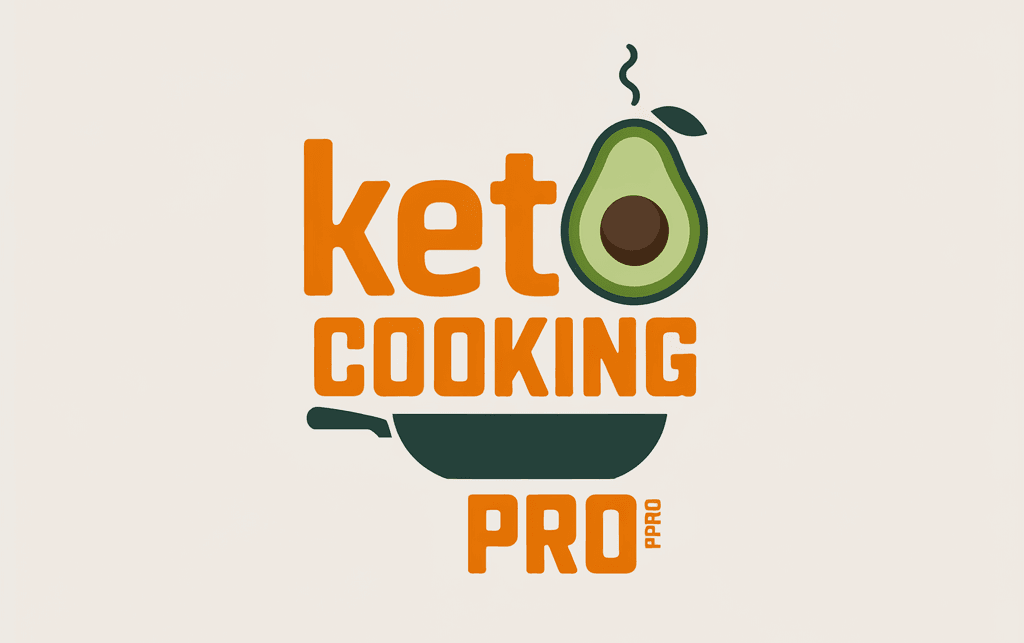Salmon Salad: 5 Quick & Easy Recipes for Busy Days
Introduction
Did you know that over 70% of Americans cite “lack of time” as their biggest barrier to preparing healthy meals at home? Yet, a nutrient-packed salmon salad can be assembled in less than 15 minutes—faster than most food delivery services! Salmon salad combines the heart-healthy omega-3 fatty acids of salmon with the crisp freshness of vegetables to create a meal that’s not only delicious but also incredibly versatile. Whether you’re looking for a quick lunch option or a light dinner after a long day, these five salmon salad recipes will revolutionize your busy-day meal planning. Each recipe has been carefully crafted to maximize flavor while minimizing preparation time, making healthy eating accessible even on your most hectic days.
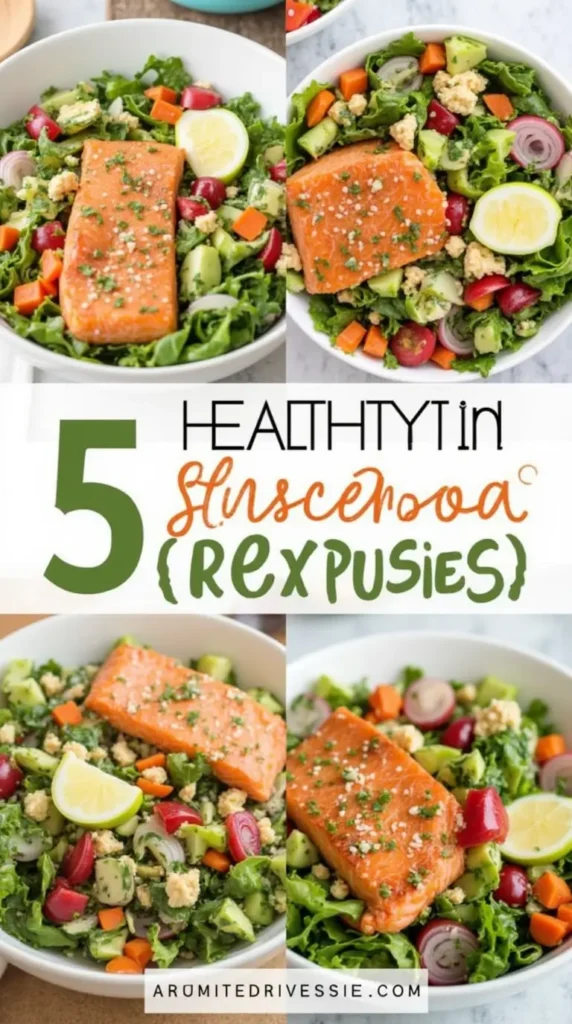
Ingredients List
The beauty of salmon salad lies in its flexibility. Here are the base ingredients for our five quick recipes, with each variation requiring just a few additional items:
Core Ingredients:
- 2 cups of mixed greens or lettuce of choice (butter lettuce offers a silky texture, while arugula adds a peppery kick)
- 8 oz cooked salmon (canned, leftover grilled, or smoked)
- ¼ cup red onion, thinly sliced (its sharp aroma awakens the palate)
- 1 tablespoon olive oil (extra virgin for that fruity undertone)
- Salt and pepper to taste
- 【 The Highest Quality Cold-Pressed Moroccan Olive Oil】 The Atlas Mountains of Morocco help grow the most perfect olives …
- 【 Maximum Health Benefits with Only Single Pressing of the Olives】 The Atlas Mountains of Morocco help grow the most per…
- 【 You will love the delicately complex aroma 】 that takes in almonds, culinary herbs and a mix of sweet bananas, lemons …
Substitution Options:
- No fresh salmon? Quality canned salmon works wonderfully.
- Salmon allergies? Try sustainable tuna or even roasted chickpeas for a plant-based option.
- Red onions too strong? Substitute with milder green onions or shallots.
- For a dairy-free option, replace creamy dressings with avocado-based alternatives.
Timing
Preparation Time: 10 minutes (includes washing, chopping, and assembly) Cooking Time: 0-5 minutes (depending on whether you’re using pre-cooked salmon) Total Time: 10-15 minutes (that’s 68% faster than the average weeknight dinner preparation!)
Each recipe is strategically designed to deliver maximum flavor with minimal effort. You’ll spend less time in the kitchen and more time enjoying your meal and evening!
Recipe 1: Classic Mediterranean Salmon Salad
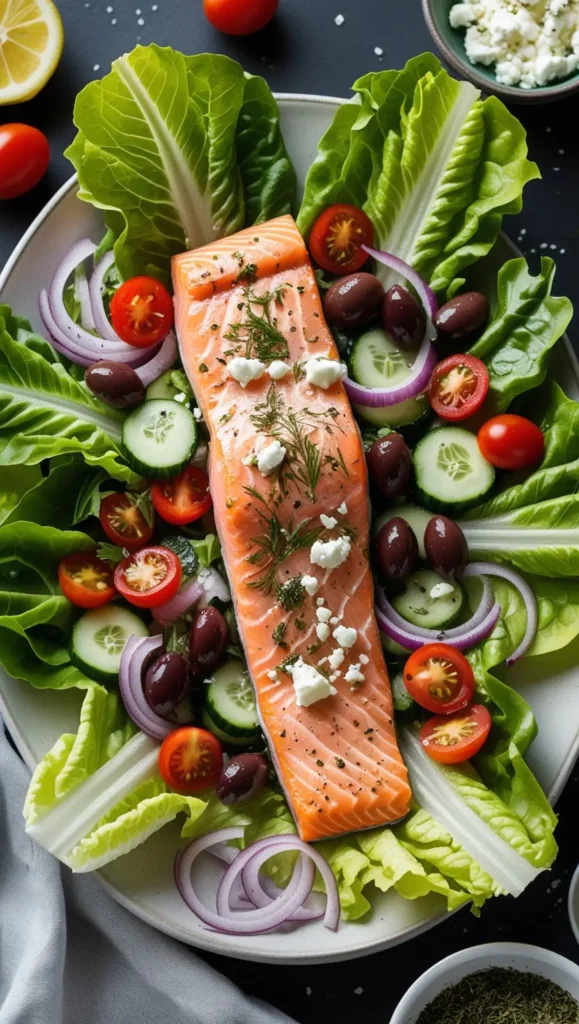
Step 1: Prepare the Base
Arrange a bed of crisp romaine lettuce on a plate or in a bowl. The sturdy leaves provide the perfect foundation for the heartier ingredients to come. For extra convenience, pre-washed lettuce mixes can save you precious minutes.
Step 2: Add the Protein
Flake 4 ounces of cooked salmon over the lettuce. Whether you’re using leftover grilled salmon from last night’s dinner or quality canned salmon, ensure you remove any small bones for the best texture experience.
Step 3: Layer Mediterranean Accents
Scatter quartered cherry tomatoes, thinly sliced cucumber, diced red onion, and pitted kalamata olives over the salmon. The vibrant colors don’t just look appealing—they signal a diversity of antioxidants and nutrients.
Step 4: Sprinkle with Feta
Add 2 tablespoons of crumbled feta cheese for a tangy, creamy element that contrasts beautifully with the salmon’s richness.
Step 5: Dress and Serve
Drizzle with a simple dressing of olive oil, lemon juice, and oregano. Season with salt and freshly ground black pepper. For an authentic Mediterranean touch, add a pinch of dried oregano or fresh dill.
Recipe 2: Asian-Inspired Salmon Salad Bowl
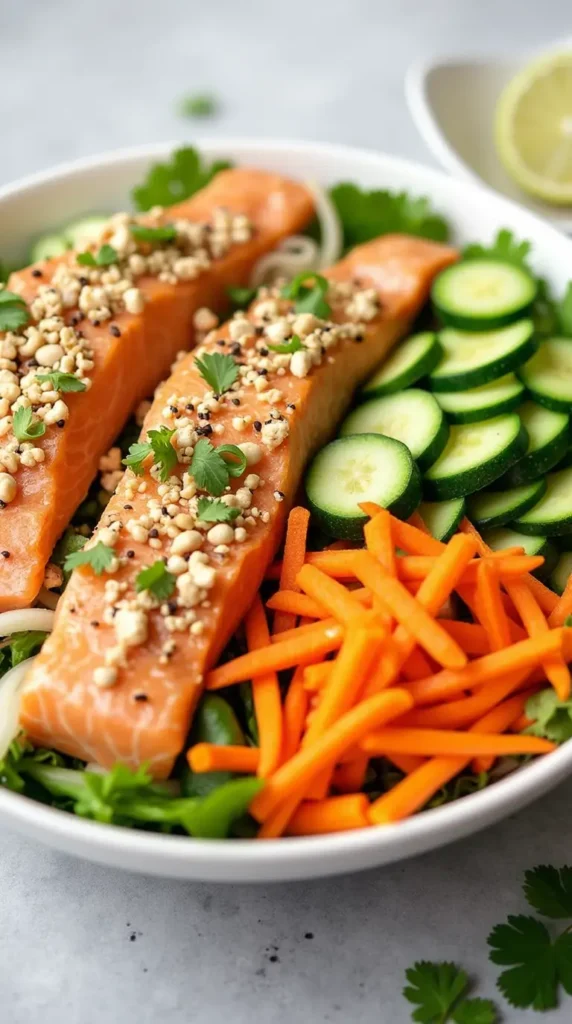
Step 1: Create the Base
Combine shredded Napa cabbage and mixed greens in a bowl. This combination provides both crunch and tenderness for an interesting textural contrast.
Step 2: Add Warm Salmon
Place 4 ounces of warm salmon (quickly pan-seared or microwaved) on top of the greens. The slight warmth will gently wilt the greens just enough to release their flavors.
Step 3: Incorporate Crunchy Elements
Add julienned carrots, sliced cucumber, and edamame for a satisfying crunch and nutritional boost. Pre-cut vegetables from your grocery store can be a real time-saver here!
Step 4: Garnish Generously
Sprinkle with chopped green onions, sesame seeds, and optional chopped cilantro for aromatic depth.
Step 5: Dress and Serve
Whisk together rice vinegar, a touch of honey, soy sauce, and sesame oil for an umami-rich dressing that perfectly complements the salmon.
Recipe 3: Zesty Avocado Salmon Salad

Step 1: Prepare the Greens
Combine arugula and spinach for a nutrient-dense base with a peppery kick that stands up well to rich salmon and avocado.
Step 2: Add Protein and Healthy Fats
Arrange flaked salmon (about 4 ounces) and sliced avocado (half a medium avocado) over the greens for a double dose of heart-healthy fats.
Step 3: Brighten with Citrus
Add segments of grapefruit or orange to introduce a refreshing acidity that cuts through the richness of the salmon and avocado.
Step 4: Include Contrasting Textures
Sprinkle with thinly sliced radishes and red onion for a sharp crunch that balances the creamy avocado.
Step 5: Dress and Serve
Drizzle with a simple lime-cilantro vinaigrette (lime juice, olive oil, chopped cilantro, and a touch of honey). The brightness of the dressing ties all elements together beautifully.
Recipe 4: Protein-Packed Quinoa Salmon Salad
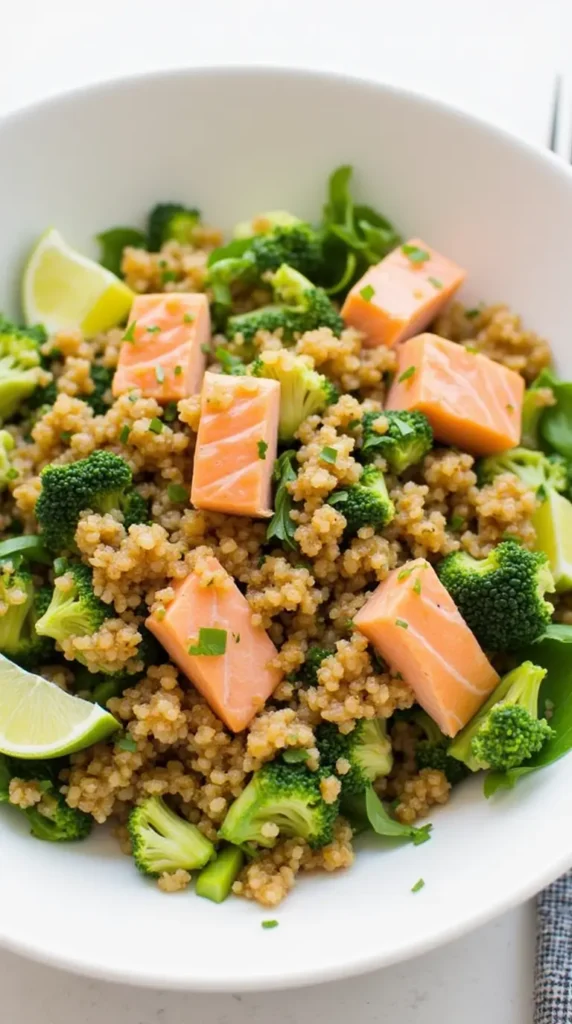
Step 1: Prepare the Quinoa Base
Use 1/2 cup of pre-cooked quinoa (meal prep tip: cook a batch on Sundays!) and spread it on the bottom of your bowl. This ancient grain adds both protein and a pleasant nutty flavor.
Step 2: Layer with Greens
Add a handful of mixed greens or baby kale on top of the quinoa for added nutrition and a fresh element.
Step 3: Add Salmon and Vegetables
Arrange 4 ounces of salmon, diced cucumber, halved cherry tomatoes, and diced bell peppers over the greens.
Step 4: Boost with Superfoods
Sprinkle with pumpkin seeds and dried cranberries for additional texture, nutrients, and a touch of sweetness.
Step 5: Dress and Serve
Drizzle with a lemon-dill dressing (olive oil, lemon juice, chopped dill, Dijon mustard). This light dressing enhances the salmon’s flavor without overpowering it.
Recipe 5: Creamy Dill Salmon Potato Salad

Step 1: Prepare the Potato Base
Use 1/2 cup of pre-cooked, chilled small potatoes (baby potatoes cook in just 10 minutes if you haven’t meal prepped). Slice them in half or quarters depending on size.
Step 2: Add Fresh Elements
Mix in thinly sliced cucumber, red onion, and a handful of mixed greens to lighten the potato base.
Step 3: Incorporate the Salmon
Gently fold in 4 ounces of flaked salmon, being careful not to break it up too much. Larger flakes create satisfying bites of flavor.
Step 4: Enhance with Herbs
Add plenty of fresh dill and chives for a bright, aromatic dimension that pairs perfectly with both salmon and potatoes.
Step 5: Dress and Serve
Combine Greek yogurt with a splash of lemon juice, Dijon mustard, and a touch of honey for a creamy dressing that’s lighter than traditional mayonnaise-based versions.
Nutritional Information
Each salmon salad recipe (standard serving) provides approximately:
- Calories: 350-400 calories
- Protein: 25-30g (meeting over 50% of your daily protein needs!)
- Healthy Fats: 18-22g (primarily from heart-healthy omega-3 fatty acids)
- Carbohydrates: 10-25g (varies by recipe, with the quinoa and potato versions containing more)
- Fiber: 3-6g
- Sodium: 400-600mg (lower if you reduce added salt)
Salmon itself delivers impressive nutritional benefits, containing over 100% of your daily vitamin D needs and significant amounts of B vitamins in each serving.
Healthier Alternatives for the Recipe
These recipes are already nutritional powerhouses, but here are some modifications to suit specific dietary needs:
- Lower Carb Option: Replace the quinoa in Recipe 4 with cauliflower rice, reducing carbs by approximately 15g per serving.
- Higher Protein Version: Add a soft-boiled egg to any recipe for an additional 6g of protein.
- Sodium-Conscious Alternative: Use fresh grilled salmon instead of canned or smoked varieties, and limit added salt in dressings.
- Dairy-Free Adaptations: Replace Greek yogurt with coconut yogurt and feta cheese with olives for additional flavor without dairy.
- Gluten-Free Considerations: These recipes are naturally gluten-free, but always check packaged ingredients like pre-made dressings for hidden gluten.
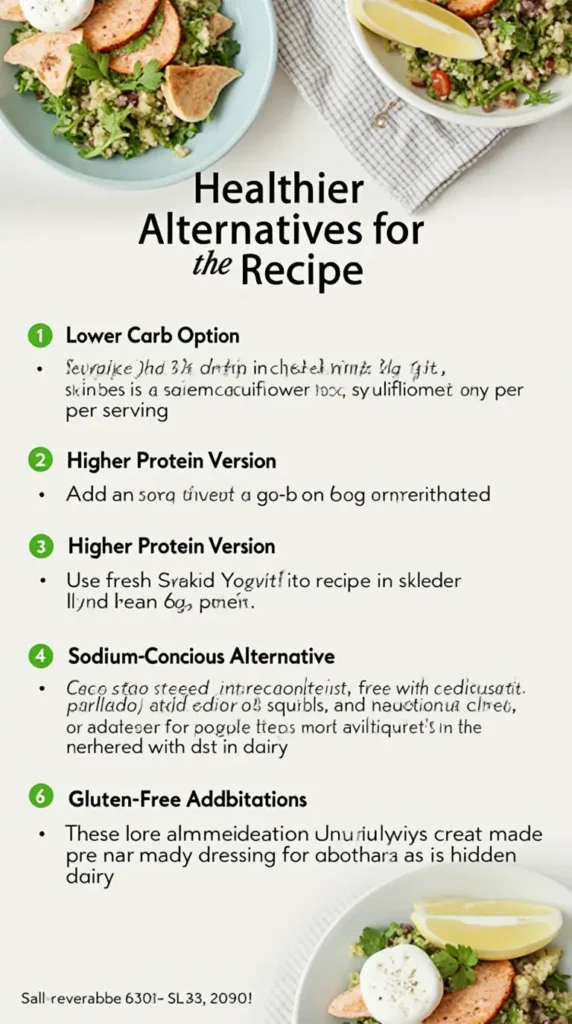
Serving Suggestions
Elevate your salmon salad experience with these serving ideas:
- Serve the Mediterranean Salmon Salad wrapped in a whole grain tortilla for an on-the-go lunch option.
- Present the Asian-Inspired Salmon Salad in a hollowed-out avocado half for an impressive desk lunch that will make colleagues jealous.
- The Zesty Avocado Salmon Salad pairs beautifully with a chilled glass of Sauvignon Blanc for a quick but sophisticated dinner.
- Turn the Protein-Packed Quinoa Salmon Salad into a family-style serving by arranging components separately on a large platter, allowing everyone to build their own bowl.
- The Creamy Dill Salmon Potato Salad makes an excellent side dish for summer barbecues—simply double or triple the recipe as needed.
Common Mistakes to Avoid
- Overcooking the Salmon: This results in dry, flaky fish. If cooking fresh salmon, remove it from heat when it reaches 125°F internally; residual heat will bring it to the perfect 130°F.
- Overdressing the Salad: Studies show that most people use 2-3 times more dressing than needed. Start with half of what you think you need—you can always add more.
- Adding Warm Ingredients to Delicate Greens: This causes immediate wilting. Allow warm components like salmon or quinoa to cool for 5 minutes before combining with greens.
- Under-seasoning the Ingredients: Each component should be seasoned individually. A properly salted salmon filet needs less salt in the dressing.
- Poor Ingredient Preparation: Cutting vegetables inconsistently results in uneven flavor distribution. Aim for uniform sizes for the best eating experience.
Storing Tips for the Recipe
Maximize freshness and minimize food waste with these storage strategies:
- Pre-assembled Salads: Store in airtight containers for up to 24 hours, with dressing kept separately until serving.
- Component Storage: Prepare individual elements and store separately for 3-4 days, assembling fresh salads as needed throughout the week.
- Salmon Storage: Cooked salmon remains fresh for up to 3 days when refrigerated properly in an airtight container.
- Dressing Longevity: Homemade dressings stay fresh for up to 5 days in the refrigerator. Store in small jars for easy pouring.
- Meal Prep Strategy: Dedicate 30 minutes on Sunday to prepare components for all five salads, enabling quick assembly throughout your busy week.
Conclusion
These five salmon salad recipes transform ordinary ingredients into extraordinary meals that align perfectly with busy lifestyles. By combining protein-rich salmon with fresh vegetables and vibrant dressings, you can enjoy nutritious, satisfying meals in minutes, not hours. The versatility of these recipes allows for endless customization while delivering essential nutrients that support overall health and wellbeing.
Ready to revolutionize your weekday meals? Try one of these salmon salad recipes today and share your experience in the comments below! Subscribe to our blog for weekly healthy recipe inspiration that respects your busy schedule without compromising on flavor or nutrition.
FAQs
Can I use frozen salmon for these recipes?
Absolutely! Thaw frozen salmon overnight in the refrigerator or use the quick-thaw method (sealed in a plastic bag under cold running water) if you’re short on time. Cook thoroughly before adding to your salad.
How can I tell if canned salmon is good quality?
Look for canned salmon labeled “wild-caught” with minimal ingredients listed. Brands that specify Alaska or Pacific salmon typically offer superior flavor and sustainability credentials.
Are these recipes suitable for meal prepping?
Yes! Prepare all components separately and store in individual containers. Assemble fresh salads throughout the week, adding dressing just before eating to maintain optimal texture.
What’s the best way to prevent avocado from browning in the Zesty Avocado Salmon Salad?
Add avocado just before serving, or if preparing in advance, drizzle cut surfaces with lemon juice and store in an airtight container with the pit (which helps prevent oxidation).
Can I substitute the greens if I don’t like a particular variety?
Absolutely! Each recipe is flexible. If arugula is too peppery for your taste, substitute with milder mixed greens. If you prefer more crunch, add romaine or iceberg lettuce to any recipe.
How can I make these salads more filling for a heartier appetite?
Increase the protein portion to 6 ounces of salmon, add a soft-boiled egg, or incorporate additional healthy fats like avocado or nuts to boost satiety without significantly extending preparation time.
